Plasmonic Enhanced Nanocrystal Infrared Photodetectors
Abstract
1. Introduction
2. Types of Infrared Photodetectors
2.1. Infrared Photodetectors with Hole Array Structures
2.1.1. 2D Materials-Based Infrared Photodetectors with Hole Array Structures
2.1.2. 1D Materials-Based Infrared Photodetectors with Hole Array Structures
2.1.3. 0D Materials-based Infrared Photodetectors with Hole Array Structures
2.2. Infrared Photodetectors with Grating Structures
2.2.1. 2D Materials-Based Infrared Photodetectors with Grating Structures
2.2.2. 1D Materials-Based Infrared Photodetectors with Grating Structures
2.3. Infrared Photodetectors with Nanoparticles
2.3.1. 2D Materials-Based Infrared Photodetectors with Nanoparticles
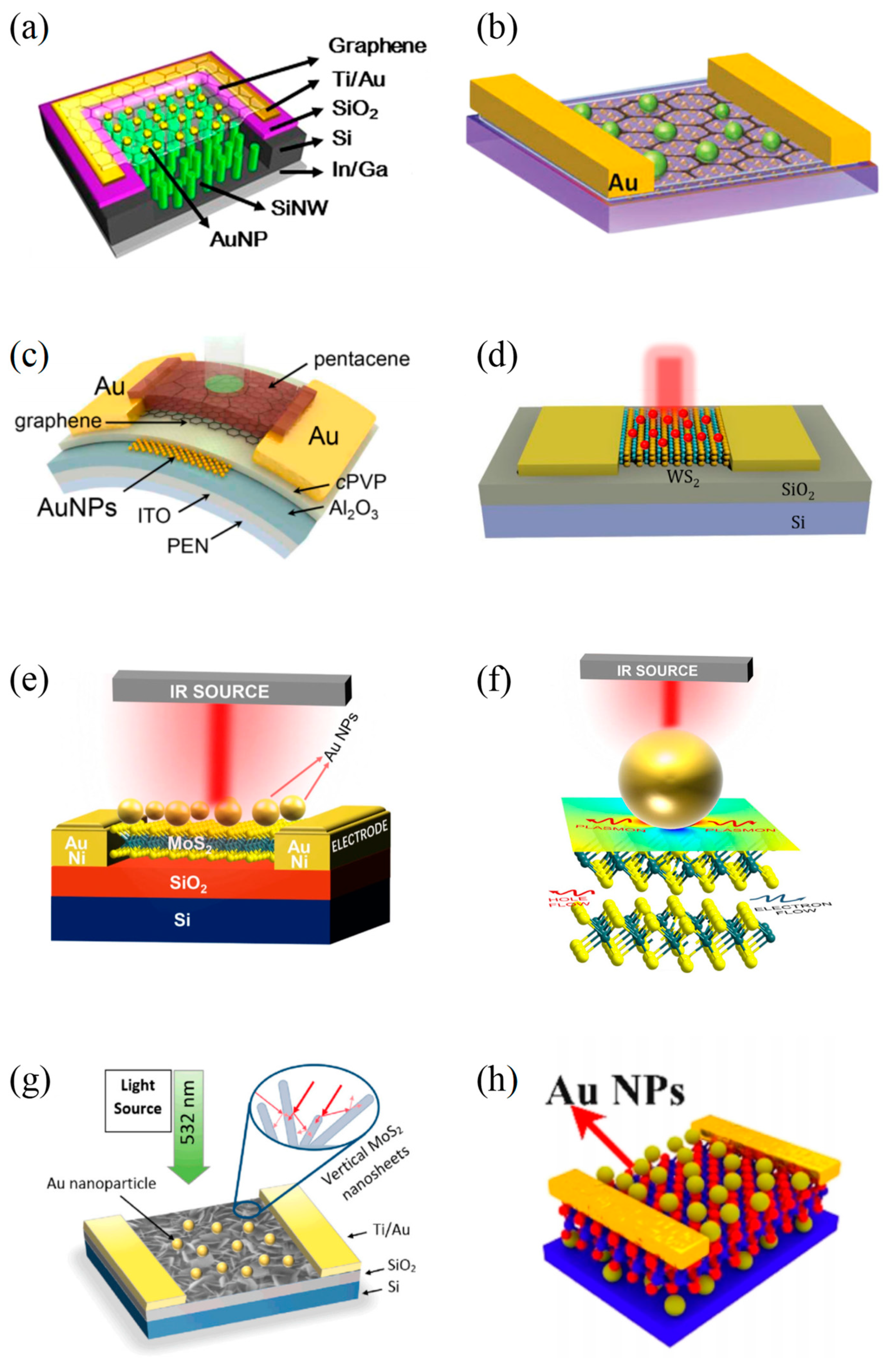
2.3.2. 1D Materials-Based Infrared Photodetectors with Nanoparticles
2.3.3. 0D Materials-Based Infrared Photodetectors with Nanoparticles
2.4. Infrared Photodetectors with Metal Array Structures
2.4.1. 2D Materials-Based Infrared Photodetectors with Metal Array Structures
2.4.2. 1D Materials-Based Infrared Photodetectors with Metal Array Structures
2.4.3. 0D Materials-Based Infrared Photodetectors with Metal Array Structures
3. Conclusions and Outlook
Author Contributions
Funding
Institutional Review Board Statement
Informed Consent Statement
Data Availability Statement
Conflicts of Interest
References
- Cohen, N.; Zussman, A.; Sarusi, G. A monolithic LWIR/NIR multispectral QWIP for night vision and see spot. Infrared Phys. Technol. 2001, 42, 391–396. [Google Scholar] [CrossRef]
- Khoshakhlagh, A.; Gunapala, S.D. Infrared imaging: A potential powerful tool for neuroimaging and neurodiagnostics. Neurophotonics 2017, 4, 011014. [Google Scholar] [CrossRef]
- Refaat, T.F.; Ismail, S.; Mack, T.L.; Abedin, M.N.; Mayor, S.D.; Spuler, S.M.; Singh, U.N. Infrared phototransistor validation for atmospheric remote sensing application using the Raman-shifted eye-safe aerosol lidar. Opt. Eng. 2007, 46, 086001. [Google Scholar]
- Chen, L.B.; Chang, W.J.; Hu, W.W.; Wang, C.K.; Lee, D.H.; Chiou, Y.Z. A band-pass IR light photodetector for wearable intelligent glasses in a drowsiness-fatigue-detection system. In Proceedings of the 2018 IEEE International Conference on Consumer Electronics (ICCE), Las Vegas, NV, USA, 12–14 January 2018; pp. 1–2. [Google Scholar]
- Chen, X.; Lu, X.; Deng, B.; Sinai, O.; Shao, Y.; Li, C.; Yuan, S.; Tran, V.; Watanabe, K.; Taniguchi, T.; et al. Widely tunable black phosphorus mid-infrared photodetector. Nat. Commun. 2017, 8, 1672. [Google Scholar] [CrossRef]
- Wang, L.; Huang, L.; Tan, W.C.; Feng, X.; Chen, L.; Huang, X.; Ang, K.W. 2D photovoltaic devices: Progress and prospects. Small Methods 2018, 2, 1700294. [Google Scholar] [CrossRef]
- Varghese, A.; Saha, D.; Thakar, K.; Jindal, V.; Ghosh, S.; Medhekar, N.V.; Ghosh, S.; Lodha, S. Near-direct bandgap WSe2/ReS2 type-II pn heterojunction for enhanced ultrafast photodetection and high-performance photovoltaics. Nano Lett. 2020, 20, 1707–1717. [Google Scholar] [CrossRef] [PubMed]
- Shrestha, V.R.; Craig, B.; Meng, J.; Bullock, J.; Javey, A.; Crozier, K.B. Mid-to long-wave infrared computational spectroscopy with a graphene metasurface modulator. Sci. Rep. 2020, 10, 5377. [Google Scholar] [CrossRef] [PubMed]
- Tian, B.; Kempa, T.J.; Lieber, C.M. Single nanowire photovoltaics. Chem. Soc. Rev. 2009, 38, 16–24. [Google Scholar] [CrossRef]
- Kim, C.J.; Lee, H.S.; Cho, Y.J.; Yang, J.E.; Lee, R.R.; Lee, J.K.; Jo, M.H. On-Nanowire Band-Graded Si: Ge Photodetectors. Adv. Mater. 2011, 23, 1025–1029. [Google Scholar] [CrossRef]
- Ren, P.; Hu, W.; Zhang, Q.; Zhu, X.; Zhuang, X.; Ma, L.; Fan, X.; Zhou, H.; Liao, L.; Duan, X.; et al. Band-selective infrared photodetectors with complete-composition-range InAsxP1-x alloy nanowires. Adv. Mater. 2014, 26, 7444–7449. [Google Scholar] [CrossRef]
- Hu, X.; Liu, H.; Wang, X.; Zhang, X.; Shan, Z.; Zheng, W.; Li, H.; Wang, X.; Zhu, X.; Jiang, Y.; et al. Wavelength selective photodetectors integrated on a single composition-graded semiconductor nanowire. Adv. Opt. Mater. 2018, 6, 1800293. [Google Scholar] [CrossRef]
- Pietryga, J.M.; Schaller, R.D.; Werder, D.; Stewart, M.H.; Klimov, V.I.; Hollingsworth, J.A. Pushing the band gap envelope: Mid-infrared emitting colloidal PbSe quantum dots. J. Am. Chem. Soc. 2004, 126, 11752–11753. [Google Scholar] [CrossRef]
- Oertel, D.C.; Bawendi, M.G.; Arango, A.C.; Bulovi’c, V. Photodetectors based on treated CdSe quantum-dot films. Appl. Phys. Lett. 2005, 87, 213505. [Google Scholar] [CrossRef]
- Keuleyan, S.; Lhuillier, E.; Brajuskovic, V.; Guyot-Sionnest, P. Mid-Infrared HgTe Colloidal Quantum Dot Photodetectors. Nat. Photonics 2011, 5, 489–493. [Google Scholar] [CrossRef]
- Shin, S.W.; Lee, K.H.; Park, J.S.; Kang, S.J. Highly transparent, visible-light photodetector based on oxide semiconductors and quantum dots. ACS Appl. Mater. Interfaces 2015, 7, 19666–19671. [Google Scholar] [CrossRef] [PubMed]
- Ackerman, M.M.; Tang, X.; Guyot-Sionnest, P. Fast and Sensitive Colloidal Quantum Dot Mid-Wave Infrared Photodetectors. ACS Nano 2018, 12, 7264–7271. [Google Scholar] [CrossRef]
- Tang, X.; Ackerman, M.M.; Chen, M.; Guyot-Sionnest, P. Dual-Band Infrared Imaging Using Stacked Colloidal Quantum Dot Photodiodes. Nat. Photonics 2019, 13, 277–282. [Google Scholar] [CrossRef]
- Ramiro, I.; Özdemir, O.; Christodoulou, S.; Gupta, S.; Dalmases, M.; Torre, I.; Konstantatos, G. Mid-and long-wave infrared optoelectronics via intraband transitions in PbS colloidal quantum dots. Nano Lett. 2020, 20, 1003–1008. [Google Scholar] [CrossRef] [PubMed]
- García de Arquer, F.P.; Talapin, D.V.; Klimov, V.I.; Arakawa, Y.; Bayer, M.; Sargent, E.H. Semiconductor quantum dots: Technological progress and future challenges. Science 2021, 373, eaaz8541. [Google Scholar] [CrossRef]
- Chen, M.; Hao, Q.; Luo, Y.; Tang, X. Mid-infrared intraband photodetector via high carrier mobility HgSe colloidal quantum dots. ACS Nano 2022, 16, 11027–11035. [Google Scholar] [CrossRef] [PubMed]
- Wood, R.W. XLII. On a remarkable case of uneven distribution of light in a diffraction grating spectrum. Lond. Edinb. Dublin Philos. Mag. J. Sci. 1902, 4, 396–402. [Google Scholar] [CrossRef]
- Fano, U. The theory of anomalous diffraction gratings and of quasi-stationary waves on metallic surfaces (Sommerfeld’s waves). J. Opt. Soc. Am. 1941, 31, 213–222. [Google Scholar] [CrossRef]
- Pines, D. Collective energy losses in solids. Rev. Mod. Phys. 1956, 28, 184. [Google Scholar] [CrossRef]
- Tamm, I.R.; Dawson, P. Surface-plasmon-enhanced Schottky barrier sensors. In Environmental and Process Monitoring Technologies; SPIE: Bellingham, WA, USA, 1992; Volume 1637, pp. 216–226. [Google Scholar]
- Sellai, A.; Dawson, P. Quantum efficiency in GaAs Schottky photodetectors with enhancement due to surface plasmon excitations. Solid State Electron. 2002, 46, 29–33. [Google Scholar] [CrossRef]
- Wu, C.M.; Jian, Z.C.; Joe, S.F.; Chang, L.B. High-sensitivity sensor based on surface plasmon resonance and heterodyne interferometry. Sens. Actuators B Chem. 2003, 92, 133–136. [Google Scholar] [CrossRef]
- Crouse, D.T. Surface plasmon effects in metal-semiconductor-metal photodetectors. In Physics and Applications of Optoelectronic Devices; SPIE: Bellingham, WA, USA, 2004; Volume 5594, pp. 45–56. [Google Scholar]
- Schaadt, D.M.; Feng, B.; Yu, E.T. Enhanced semiconductor optical absorption via surface plasmon excitation in metal nanoparticles. Appl. Phys. Lett. 2005, 86, 063106. [Google Scholar] [CrossRef]
- Basyooni, M.A.; Ahmed, A.M.; Shaban, M. Plasmonic hybridization between two metallic nanorods. Optik 2018, 172, 1069–1078. [Google Scholar] [CrossRef]
- Li, X.; Zhu, J.; Wei, B. Hybrid nanostructures of metal/two-dimensional nanomaterials for plasmon-enhanced applications. Chem. Soc. Rev. 2016, 45, 3145–3187. [Google Scholar] [CrossRef]
- Ebbesen, T.W.; Lezec, H.J.; Ghaemi, H.F.; Thio, T.; Wolff, P.A. Extraordinary optical transmission through sub-wavelength hole arrays. Nature 1998, 391, 667–669. [Google Scholar] [CrossRef]
- Wang, J.; Han, J.; Chen, X.; Wang, X. Design strategies for two-dimensional material photodetectors to enhance device performance. InfoMat 2019, 1, 33–53. [Google Scholar] [CrossRef]
- Wu, W.; Bonakdar, A.; Mohseni, H. Plasmonic enhanced quantum well infrared photodetector with high detectivity. Appl. Phys. Lett. 2010, 96, 161107. [Google Scholar] [CrossRef]
- Venuthurumilli, P.K.; Ye, P.D.; Xu, X. Plasmonic resonance enhanced polarization-sensitive photodetection by black phosphorus in near infrared. ACS Nano 2018, 12, 4861–4867. [Google Scholar] [CrossRef]
- Zhou, S.; Chen, K.; Guo, X.; Cole, M.T.; Wu, Y.; Li, Z.; Zhang, S.; Li, C.; Dai, Q. Antenna-coupled vacuum channel nano-diode with high quantum efficiency. Nanoscale 2020, 12, 1495–1499. [Google Scholar] [CrossRef]
- Shabbir, M.W.; Chandra, S.; Leuenberger, M.N. Numerical simulations of nanolayered heterostructures of nanopatterned graphene and vanadium oxide for mid-infrared photodetectors operating close to room temperature. ACS Appl. Nano Mater. 2022, 5, 2094–2101. [Google Scholar] [CrossRef]
- Senanayake, P.; Hung, C.H.; Shapiro, J.; Lin, A.; Liang, B.; Williams, B.S.; Huffaker, D.L. Surface plasmon-enhanced nanopillar photodetectors. Nano Lett. 2011, 11, 5279–5283. [Google Scholar] [CrossRef]
- Lee, W.J.; Senanayake, P.; Farrell, A.C.; Lin, A.; Hung, C.H.; Huffaker, D.L. High quantum efficiency nanopillar photodiodes overcoming the diffraction limit of light. Nano Lett. 2016, 16, 199–204. [Google Scholar] [CrossRef]
- Ren, D.; Rong, Z.; Azizur-Rahman, K.M.; Somasundaram, S.; Shahili, M.; Huffaker, D.L. Feasibility of achieving high detectivity at short-and mid-wavelength infrared using nanowire-plasmonic photodetectors with p–n heterojunctions. Nanotechnology 2018, 30, 044002. [Google Scholar] [CrossRef] [PubMed]
- Ren, D.; Meng, X.; Rong, Z.; Cao, M.; Farrell, A.C.; Somasundaram, S.; Azizur-Rahman, K.M.; Williams, B.S.; Huffaker, D.L. Uncooled photodetector at short-wavelength infrared using InAs nanowire photoabsorbers on InP with p–n heterojunctions. Nano Lett. 2018, 18, 7901–7908. [Google Scholar] [CrossRef]
- Ren, D.; Azizur-Rahman, K.M.; Rong, Z.; Juang, B.C.; Somasundaram, S.; Shahili, M.; Farrell, A.C.; Williams, B.S.; Huffaker, D.L. Room-temperature midwavelength infrared InAsSb nanowire photodetector arrays with Al2O3 passivation. Nano Lett. 2019, 19, 2793–2802. [Google Scholar] [CrossRef] [PubMed]
- Guo, R.; Zhang, M.; Ding, J.; Liu, A.; Huang, F.; Sheng, M. Advances in colloidal quantum dot-based photodetectors. J. Mater. Chem. C 2022, 10, 7404–7422. [Google Scholar] [CrossRef]
- Chang, C.-C.; Sharma, Y.D.; Kim, Y.-S.; Bur, J.A.; Shenoi, R.V.; Krishna, S.; Huang, D.; Lin, S.-Y. A surface plasmon enhanced infrared photodetector based on InAs quantum dots. Nano Lett. 2010, 10, 1704–1709. [Google Scholar] [CrossRef]
- Liu, R.; Vasinajindakaw, P.; Gu, G.; Vaillancourt, J.; Lu, X. Optimizing light absorption in quantum dot infrared photodetectors by tuning surface confinement of surface plasmonic waves. J. Phys. D Appl. Phys. 2012, 46, 015102. [Google Scholar] [CrossRef]
- Yakimov, A.I.; Kirienko, V.V.; Bloshkin, A.A.; Armbrister, V.A.; Dvurechenskii, A.V. Plasmon polariton enhanced mid-infrared photodetectors based on Ge quantum dots in Si. J. Appl. Phys. 2017, 122, 133101. [Google Scholar] [CrossRef]
- Yakimov, A.I.; Kirienko, V.V.; Bloshkin, A.A.; Armbrister, V.A.; Dvurechenskii, A.V.; Hartmann, J.M. Photovoltaic Ge/SiGe quantum dot mid-infrared photodetector enhanced by surface plasmons. Opt. Express 2017, 25, 25602–25611. [Google Scholar] [CrossRef]
- Yakimov, A.I.; Kirienko, V.V.; Dvurechenskii, A.V. Comparison of two-dimensional arrays of gold disks and holes for plasmonic enhancement of Ge/Si quantum dot mid-infrared photodetectors. Opt. Mater. Express 2018, 8, 3479–3484. [Google Scholar] [CrossRef]
- Yakimov, A.; Kirienko, V.; Bloshkin, A.; Dvurechenskii, A.; Utkin, D. Quantum dot based mid-infrared photodetector enhanced by a hybrid metal-dielectric optical antenna. J. Phys. D Appl. Phys. 2020, 53, 335105. [Google Scholar] [CrossRef]
- Dorodnyy, A.; Salamin, Y.; Ma, P.; Plestina, J.V.; Lassaline, N.; Mikulik, D.; Romero-Gomez, P.; Morral, A.F.; Leuthold, J. Plasmonic photodetectors. IEEE J. Sel. Top. Quantum Electron. 2018, 24, 1–13. [Google Scholar] [CrossRef]
- Zhao, B.; Zhao, J.M.; Zhang, Z.M. Enhancement of near-infrared absorption in graphene with metal gratings. Appl. Phys. Lett. 2014, 105, 031905. [Google Scholar] [CrossRef]
- Zhao, B.; Zhang, Z.M. Strong plasmonic coupling between graphene ribbon array and metal gratings. ACS Photonics 2015, 2, 1611–1618. [Google Scholar] [CrossRef]
- Zhang, Y.; Meng, D.; Li, X.; Yu, H.; Lai, J.; Fan, Z.; Chen, C. Significantly enhanced infrared absorption of graphene photodetector under surface-plasmonic coupling and polariton interference. Opt. Express 2018, 26, 30862–30872. [Google Scholar] [CrossRef]
- Li, J.; Zhao, C.; Liu, B.; You, C.; Chu, F.; Tian, N.; Chen, Y.; Li, S.; An, B.; Cui, A.; et al. Metamaterial grating-integrated graphene photodetector with broadband high responsivity. Appl. Surf. Sci. 2019, 473, 633–640. [Google Scholar] [CrossRef]
- Huang, Y.; Liu, X.; Liu, Y.; Shao, Y.; Zhang, S.; Fang, C.; Han, G.; Zhang, J.; Hao, Y. Nanostructured multiple-layer black phosphorus photodetector based on localized surface plasmon resonance. Opt. Mater. Express 2019, 9, 739–750. [Google Scholar] [CrossRef]
- Lien, M.R.; Wang, N.; Wu, J.; Soibel, A.; Gunapala, S.D.; Wang, H.; Povinelli, M.L. Resonant Grating-Enhanced Black Phosphorus Mid-Wave Infrared Photodetector. Nano Lett. 2022, 22, 8704–8710. [Google Scholar] [CrossRef] [PubMed]
- Zhang, Y.; Wang, B.; Wang, L.; Shao, J.; Yang, M.; Sun, H.; Zhang, N.; Jing, Z.; Hu, H. Dual-band plasmon-enhanced and bias-dependent responsivity in a flask-shaped Ge nanowire photodetector with Au grating. Appl. Phys. Lett. 2021, 119, 131107. [Google Scholar] [CrossRef]
- Zhang, Y.; Li, Y.; Yuan, X.; Yan, X.; Zhang, X. High-performance laterally oriented nanowire solar cells with Ag gratings. Nanomaterials 2021, 11, 2807. [Google Scholar] [CrossRef]
- Siampour, H.; Dan, Y. Si nanowire phototransistors at telecommunication wavelengths by plasmon-enhanced two-photon absorption. Opt. Express 2016, 24, 4601–4609. [Google Scholar] [CrossRef] [PubMed]
- Luo, M.C.; Ren, F.F.; Gagrani, N.; Qiu, K.; Wang, Q.; Yu, L.; Ye, J.; Yan, F.; Zhang, R.; Tan, H.H.; et al. Polarization-Independent Indium Phosphide Nanowire Photodetectors. Adv. Opt. Mater. 2020, 8, 2000514. [Google Scholar] [CrossRef]
- Rashidi, M.; Asgari, A. Investigating the impact of metallic nanoparticles on performance of nanowire-based plasmonic photodetectors. IET Optoelectron. 2020, 14, 406–410. [Google Scholar] [CrossRef]
- Hosseini, Z.S.; Bafrani, H.A.; Naseri, A.; Moshfegh, A.Z. High-performance UV-Vis-NIR photodetectors based on plasmonic effect in Au nanoparticles/ZnO nanofibers. Appl. Surf. Sci. 2019, 483, 1110–1117. [Google Scholar] [CrossRef]
- Luo, L.B.; Zeng, L.H.; Xie, C.; Yu, Y.Q.; Liang, F.X.; Wu, C.Y.; Wang, L.; Hu, J.G. Light trapping and surface plasmon enhanced high-performance NIR photodetector. Sci. Rep. 2014, 4, 3914. [Google Scholar] [CrossRef]
- Niu, W.; Chen, H.; Chen, R.; Huang, J.; Palaniappan, A.; Sun, H.; Liedberg, B.G.; Tok, A. Synergetically Enhanced Near-Infrared Photoresponse of Reduced Graphene Oxide by Upconversion and Gold Plasmon. Small 2014, 10, 3637–3643. [Google Scholar] [CrossRef]
- Jang, S.; Hwang, E.; Lee, Y.; Lee, S.; Cho, J.H. Multifunctional graphene optoelectronic devices capable of detecting and storing photonic signals. Nano Lett. 2015, 15, 2542–2547. [Google Scholar] [CrossRef]
- Miao, J.; Hu, W.; Jing, Y.; Luo, W.; Liao, L.; Pan, A.; Wu, S.; Cheng, J.; Chen, X.; Lu, W. Surface plasmon-enhanced photodetection in few layer MoS2 phototransistors with Au nanostructure arrays. Small 2015, 11, 2392–2398. [Google Scholar] [CrossRef]
- Liu, Y.; Huang, W.; Chen, W.; Wang, X.; Guo, J.; Tian, H.; Zhang, H.; Wang, Y.; Yu, B.; Ren, T.; et al. Plasmon resonance enhanced WS2 photodetector with ultra-high sensitivity and stability. Appl. Surf. Sci. 2019, 481, 1127–1132. [Google Scholar] [CrossRef]
- Guo, J.; Li, S.; He, Z.; Li, Y.; Lei, Z.; Liu, Y.; Huang, W.; Gong, T.; Ai, Q.; Mao, L.; et al. Near-infrared photodetector based on few-layer MoS2 with sensitivity enhanced by localized surface plasmon resonance. Appl. Surf. Sci. 2019, 483, 1037–1043. [Google Scholar] [CrossRef]
- Rahmati, B.; Hajzadeh, I.; Taheri, M.; Karimzadeh, R.; Mohajerzadeh, S.; Mohseni, S.M. Plasmonic improvement photoresponse of vertical-MoS2 nanostructure photodetector by Au nanoparticles. Appl. Surf. Sci. 2019, 490, 165–171. [Google Scholar] [CrossRef]
- Jeon, S.; Jia, J.; Ju, J.H.; Lee, S. Black phosphorus photodetector integrated with Au nanoparticles. Appl. Phys. Lett. 2019, 115, 183102. [Google Scholar] [CrossRef]
- Sun, X.; Sun, J.; Xu, J.; Li, Z.; Li, R.; Yang, Z.; Ren, F.; Jia, Y.; Chen, F. A Plasmon-Enhanced SnSe2 Photodetector by Non-Contact Ag Nanoparticles. Small 2021, 17, 2102351. [Google Scholar] [CrossRef] [PubMed]
- Nakazawa, T.; Kim, D.; Kato, S.; Park, J.; Nam, J.; Kim, H. Photocurrent enhancement of PtSe2 photodetectors by using Au nanorods. Photonics 2021, 8, 505. [Google Scholar] [CrossRef]
- Li, G.; Song, Y.; Feng, S.; Feng, L.; Liu, Z.; Leng, B.; Fu, Z.; Li, J.; Jiang, X.; Liu, B.; et al. Improved Optoelectronic Performance of MoS2 Photodetector via Localized Surface Plasmon Resonance Coupling of Double-Layered Au Nanoparticles with Sandwich Structure. ACS Appl. Electron. Mater. 2022, 4, 1626–1632. [Google Scholar] [CrossRef]
- Zhou, C.; Wang, S.; Sun, J.; Wei, N.; Yang, L.; Zhang, Z.; Liao, J.; Peng, L.M. Plasmonic enhancement of photocurrent in carbon nanotube by Au nanoparticles. Appl. Phys. Lett. 2013, 102, 103102. [Google Scholar] [CrossRef]
- Jee, S.W.; Zhou, K.; Kim, D.W.; Lee, J.H. A silicon nanowire photodetector using Au plasmonic nanoantennas. Nano Converg. 2014, 1, 29. [Google Scholar] [CrossRef]
- Qi, T.; Yu, Y.; Liu, J.; Jia, Y.; Ding, D. Enhanced Performance of Single-Walled Carbon Nanotube-Germanium Near-Infrared Photodetector by Doping with Au Nanoparticles. Photonics 2022, 9, 615. [Google Scholar] [CrossRef]
- Zhu, X.; Meng, B.; Wang, D.; Chen, X.; Liao, L.; Jiang, M.; Wei, Z. Improving the performance of a GaAs nanowire photodetector using surface plasmon polaritons. Chin. Phys. B 2022, 31, 047801. [Google Scholar] [CrossRef]
- Pelayo García de Arquer, F.; Beck, F.J.; Bernechea, M.; Konstantatos, G. Plasmonic Light Trapping Leads to Responsivity Increase in Colloidal Quantum Dot Photodetectors. Appl. Phys. Lett. 2012, 100, 043101. [Google Scholar] [CrossRef]
- He, J.; Qiao, K.; Gao, L.; Song, H.; Hu, L.; Jiang, S.; Zhong, J.; Tang, J. Synergetic effect of silver nanocrystals applied in PbS colloidal quantum dots for high-performance infrared photodetectors. ACS Photonics 2014, 1, 936–943. [Google Scholar] [CrossRef]
- Chen, M.; Shao, L.; Kershaw, S.V.; Yu, H.; Wang, J.; Rogach, A.L.; Zhao, N. Photocurrent enhancement of HgTe quantum dot photodiodes by plasmonic gold nanorod structures. ACS Nano 2014, 8, 8208–8216. [Google Scholar] [CrossRef]
- Zhao, X.; Duan, Y.; Li, K.; Fang, Y.; Song, X.; Zhang, H.; Yu, H. Au–PbS core–shell nanorods for plasmon-enhanced near-infrared photodetection. J. Mater. Sci. 2019, 54, 14720–14727. [Google Scholar] [CrossRef]
- Zhao, X.; Duan, Y.; Li, K.; Fang, Y.; Song, X.; Zhang, H.; Wang, P.; Yan, Z. Sandwiched PbS/Au/PbS phototransistor for surface plasmon enhanced near-infrared photodetection. J. Alloys Compd. 2020, 815, 152331. [Google Scholar] [CrossRef]
- Fang, Z.; Liu, Z.; Wang, Y.; Ajayan, P.M.; Nordlander, P.; Halas, N.J. Graphene-Antenna Sandwich Photodetector. Nano Lett. 2012, 12, 3808–3813. [Google Scholar] [CrossRef]
- Fang, Z.; Wang, Y.; Liu, Z.; Schlather, A.; Ajayan, P.M.; Koppens, F.H.L.; Nordlander, P.; Halas, N.J. Plasmon-Induced Doping of Graphene. ACS Nano 2012, 6, 10222–10228. [Google Scholar] [CrossRef]
- Zhang, J.; Boora, M.; Kaminski, T.; Kendrick, C.; Yap, Y.K.; Suh, J.Y. Fano resonances from plasmon-exciton coupling in hetero-bilayer WSe2-WS2 on Au nanorod arrays. Photonics Nanostruct. 2020, 41, 100783. [Google Scholar] [CrossRef]
- Yang, Z.; Li, Y.; Guo, Q.; Huang, H.; Jiang, B.; He, X.; Zou, X.; Liu, X.; Shan, F. Cladded Surface-Plasmon-Enhanced BP Photodetector Based on the Damage-Free Metal-Semiconductor Interface. IEEE Trans. Electron Devices 2021, 68, 164–167. [Google Scholar] [CrossRef]
- Gu, Q.; Hu, C.; Yang, J.; Lv, J.; Ying, Y.; Jiang, X.; Si, G. Plasmon enhanced perovskite-metallic photodetectors. Mater. Des. 2021, 198, 109374. [Google Scholar] [CrossRef]
- Guskov, A.; Avdizhiyan, A.; Lavrov, S.; Galiev, R.; Gorbatova, A.; Buryakov, A.; Mishina, E. Sensitivity enhancement of two-dimensional WSe2-based photodetectors by ordered Ag plasmonic nanostructures. Appl. Phys. Express 2021, 14, 075005. [Google Scholar] [CrossRef]
- Casadei, A.; Pecora, E.F.; Trevino, J.; Forestiere, C.; Rüffer, D.; Russo-Averchi, E.; Matteini, F.; Tutuncuoglu, G.; Heiss, M.; Fontcuberta, I.; et al. Photonic-Plasmonic Coupling of GaAs Single Nanowires to Optical Nanoantennas. Nano Lett. 2014, 14, 2271–2278. [Google Scholar] [CrossRef] [PubMed]
- Yadav, V.K.; Nath, A.; Das, A.; Mazumder, J.T.; Sarkar, M.B. Indium Nanoparticles Capped TiO Nanowire Array for Boosted Photosensing Adoption. IEEE Electron Device Lett. 2021, 42, 192–195. [Google Scholar] [CrossRef]
- Tang, X.; Wu, G.; Lai, K.W.C. Plasmon Resonance Enhanced Colloidal HgSe Quantum Dot Filterless Narrowband Photodetectors for Mid-Wave Infrared. J. Mater. Chem. C 2017, 5, 362–369. [Google Scholar] [CrossRef]
- Tang, X.; Ackerman, M.M.; Guyot-Sionnest, P. Thermal Imaging with Plasmon Resonance Enhanced HgTe Colloidal Quantum Dot Photovoltaic Devices. ACS Nano 2018, 12, 7362–7370. [Google Scholar] [CrossRef]
- Yakimov, A.I.; Kirienko, V.V.; Bloshkin, A.A.; Dvurechenskii, A.V.; Utkin, D.E. Near-Infrared Photoresponse in Ge/Si Quantum Dots Enhanced by Localized Surface Plasmons Supported by Aluminum Nanodisks. J. Appl. Phys. 2020, 128, 143101. [Google Scholar] [CrossRef]
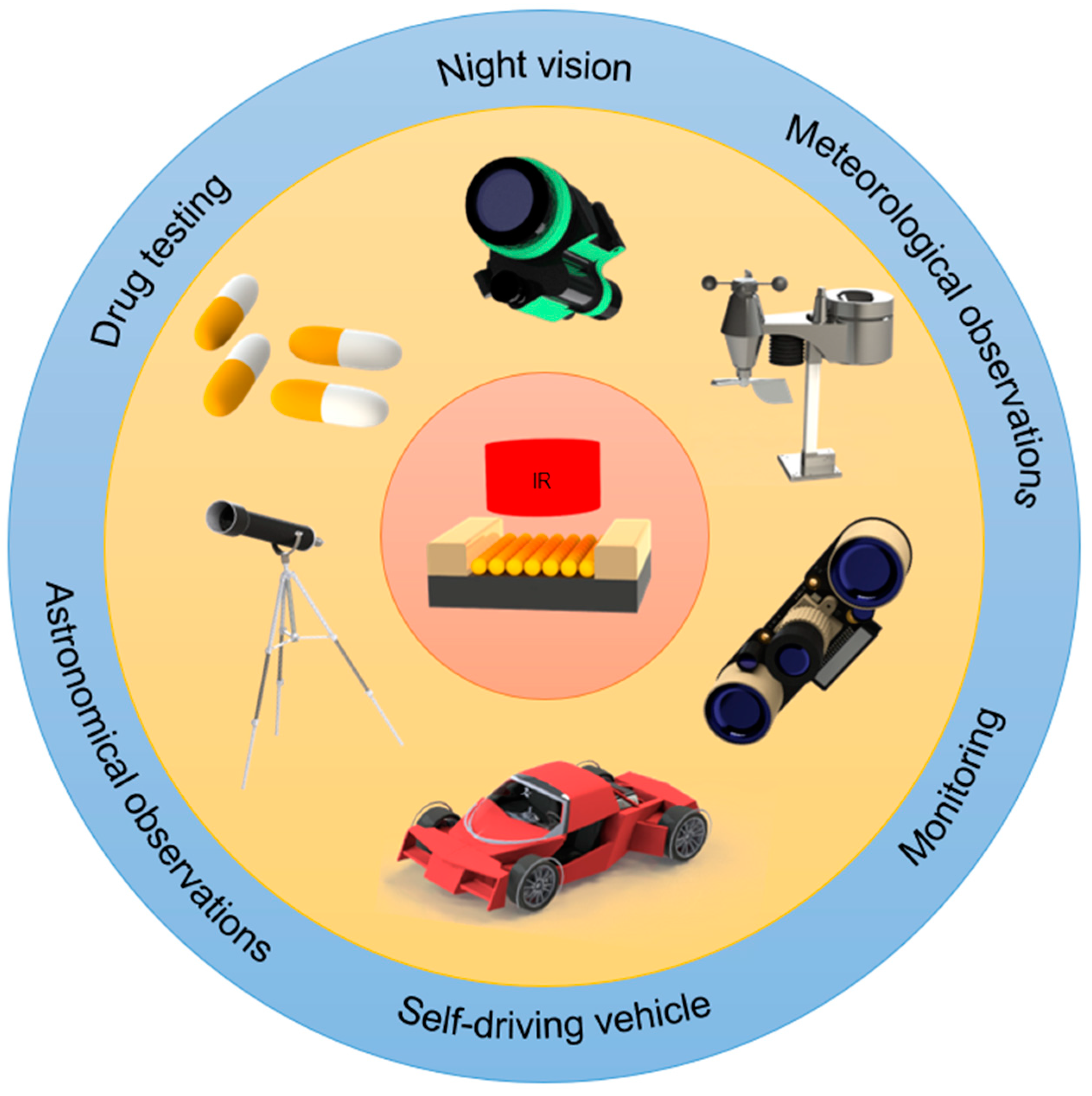
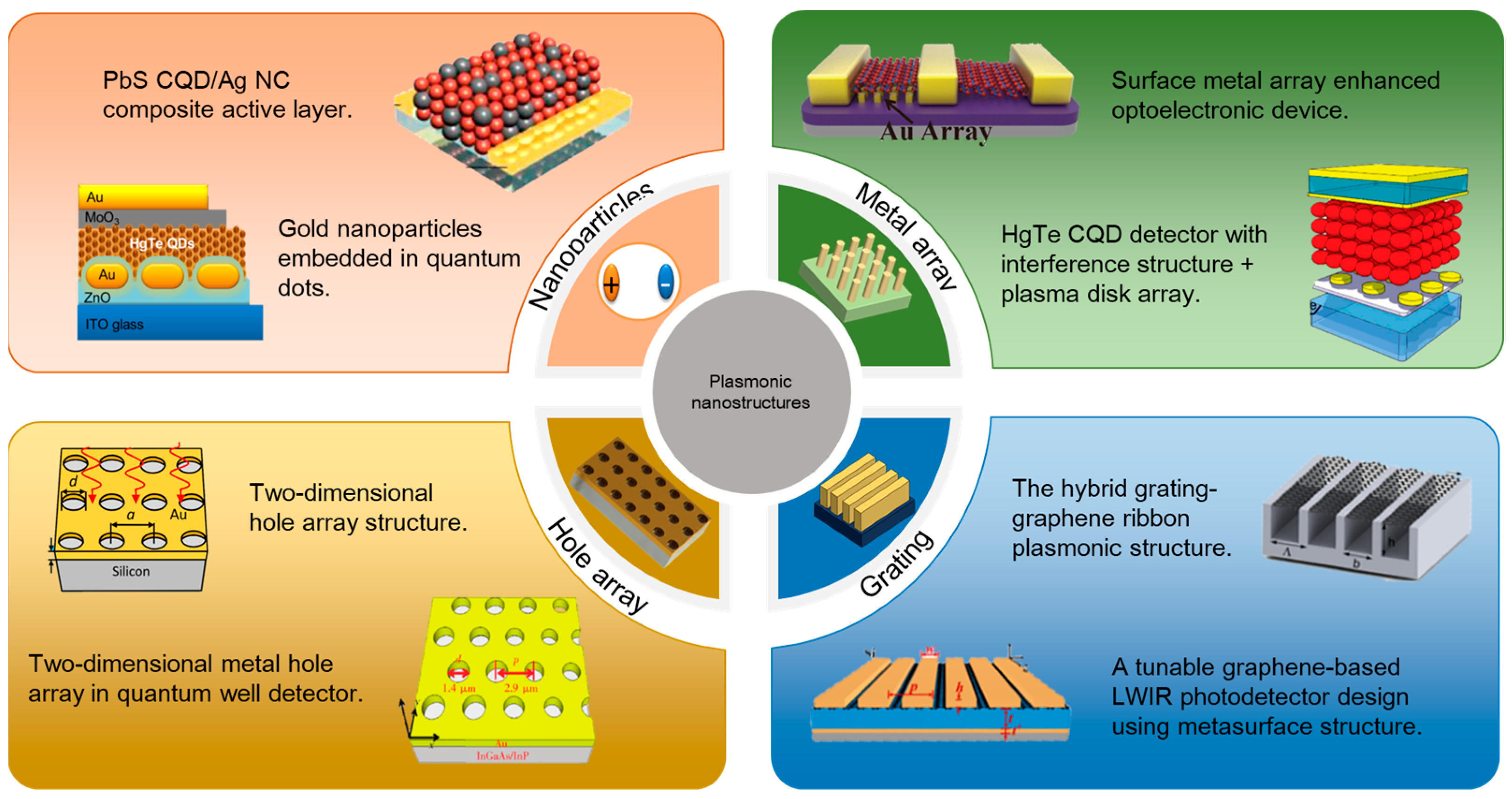

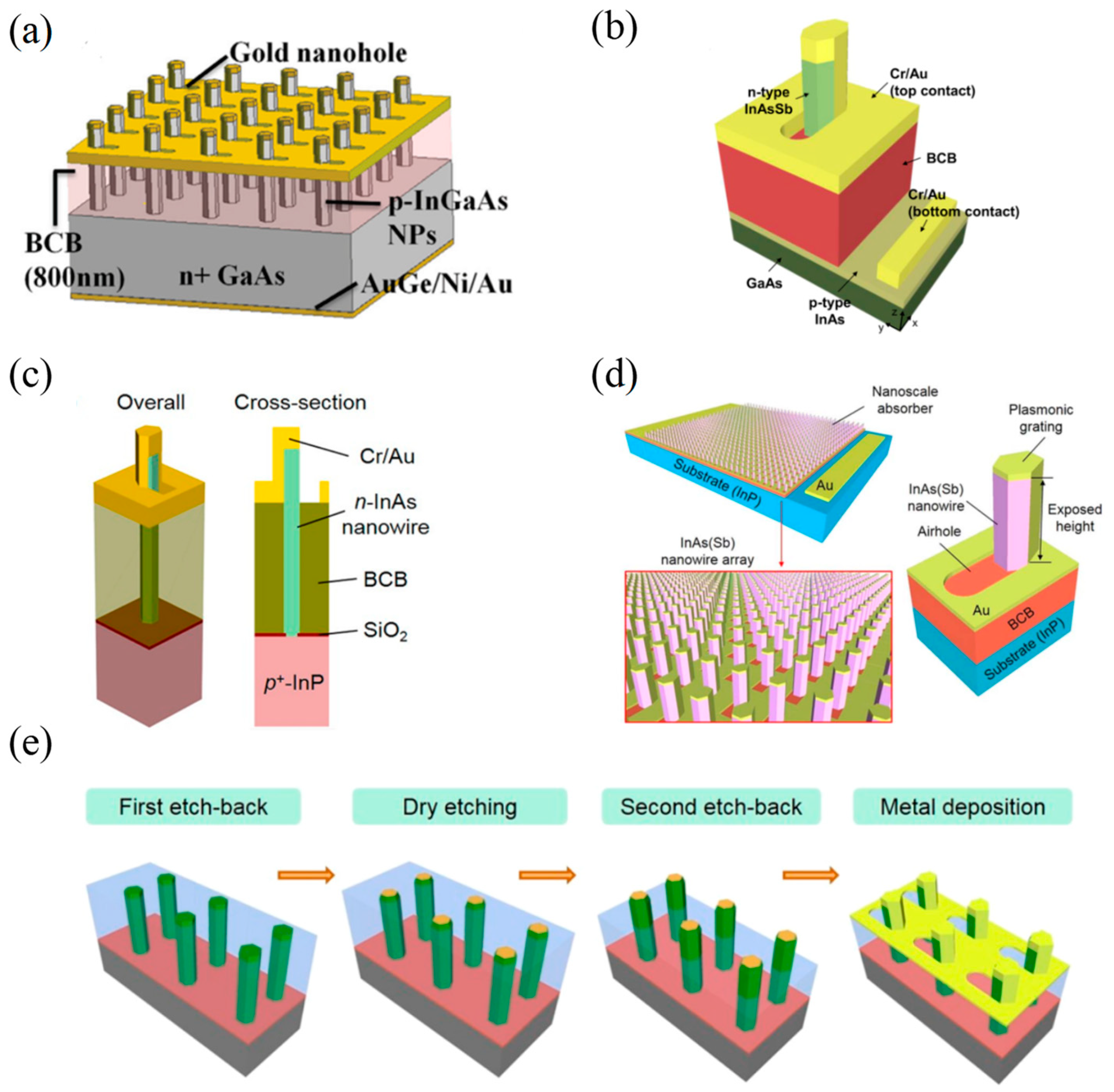
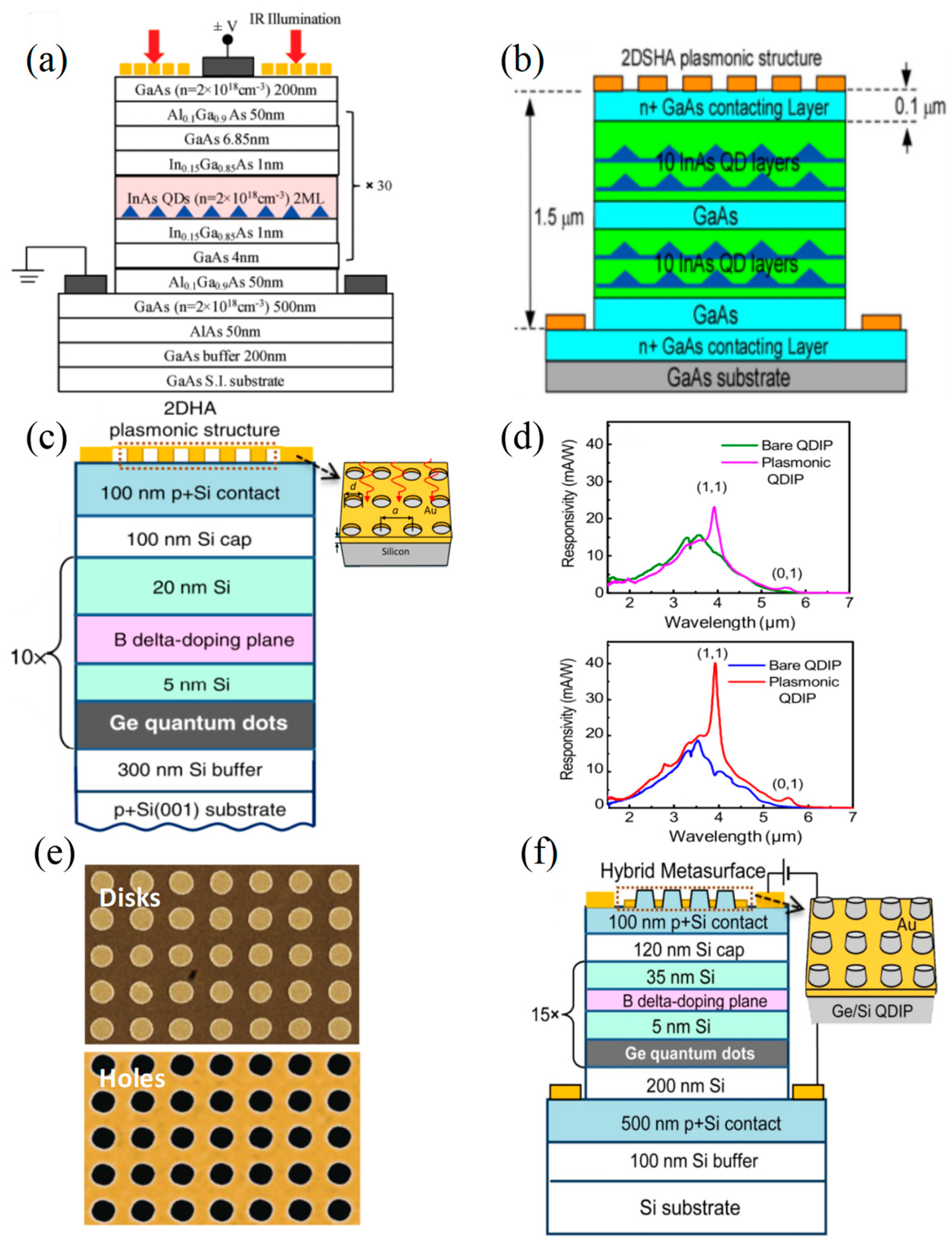
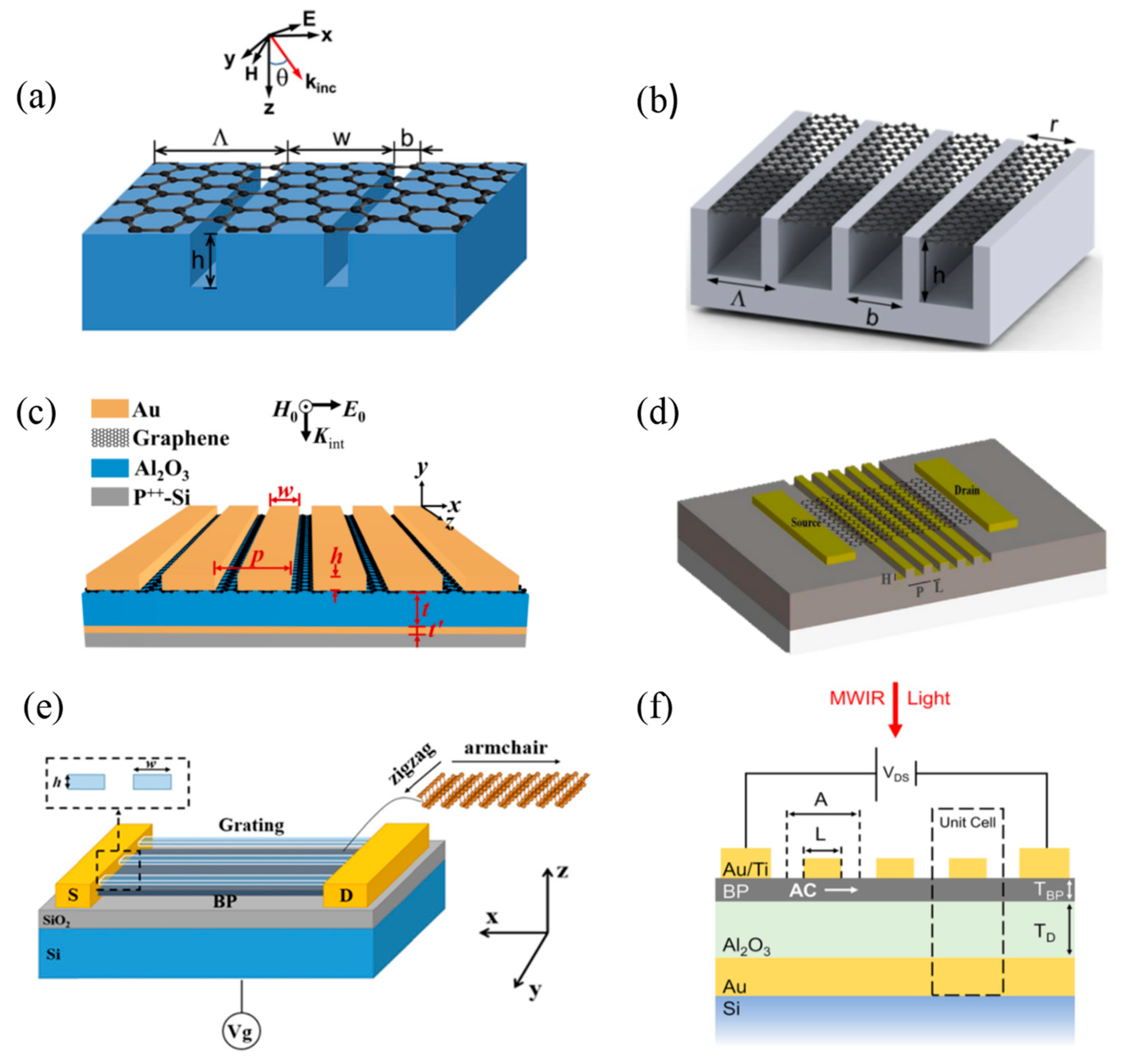


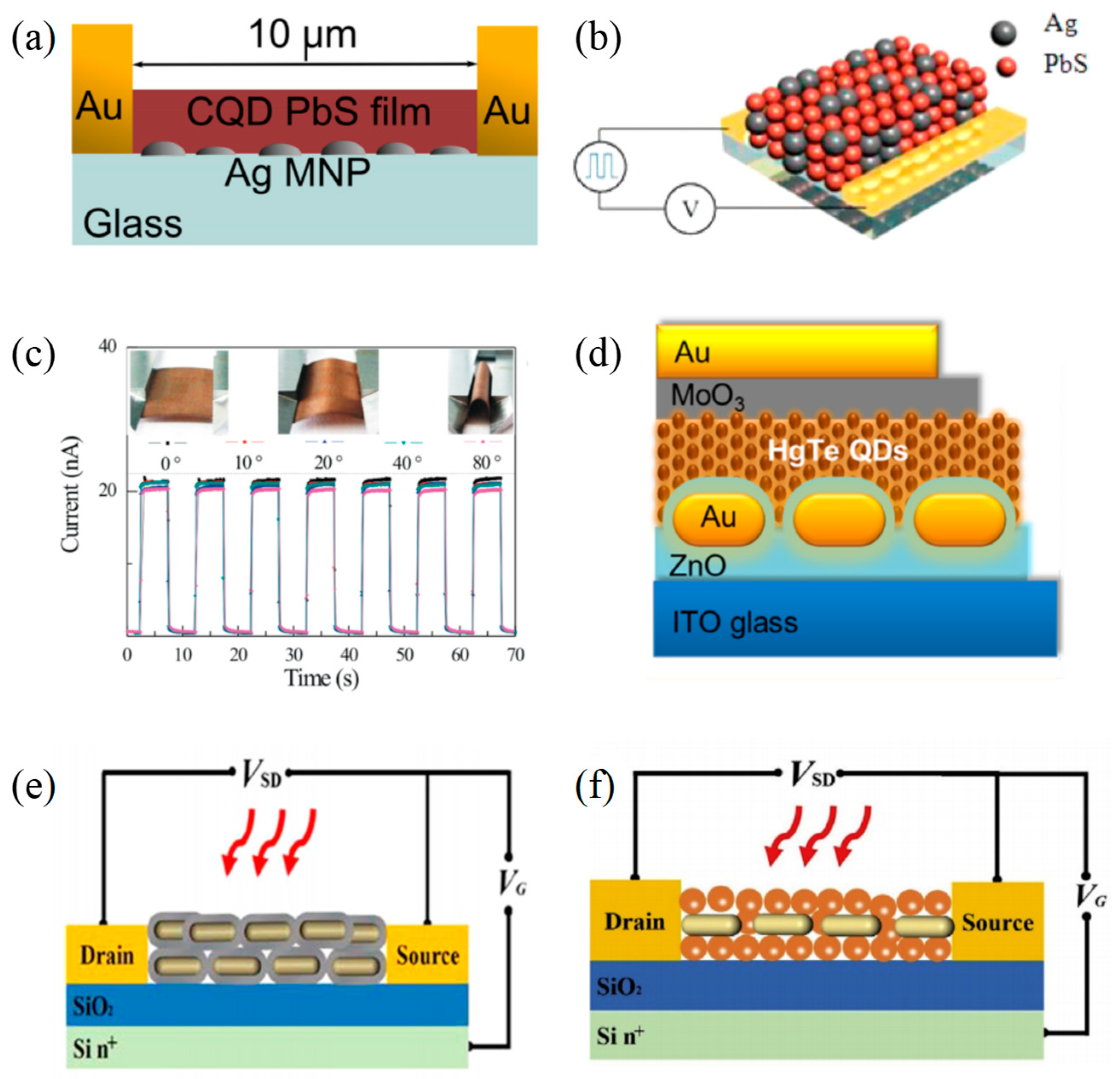
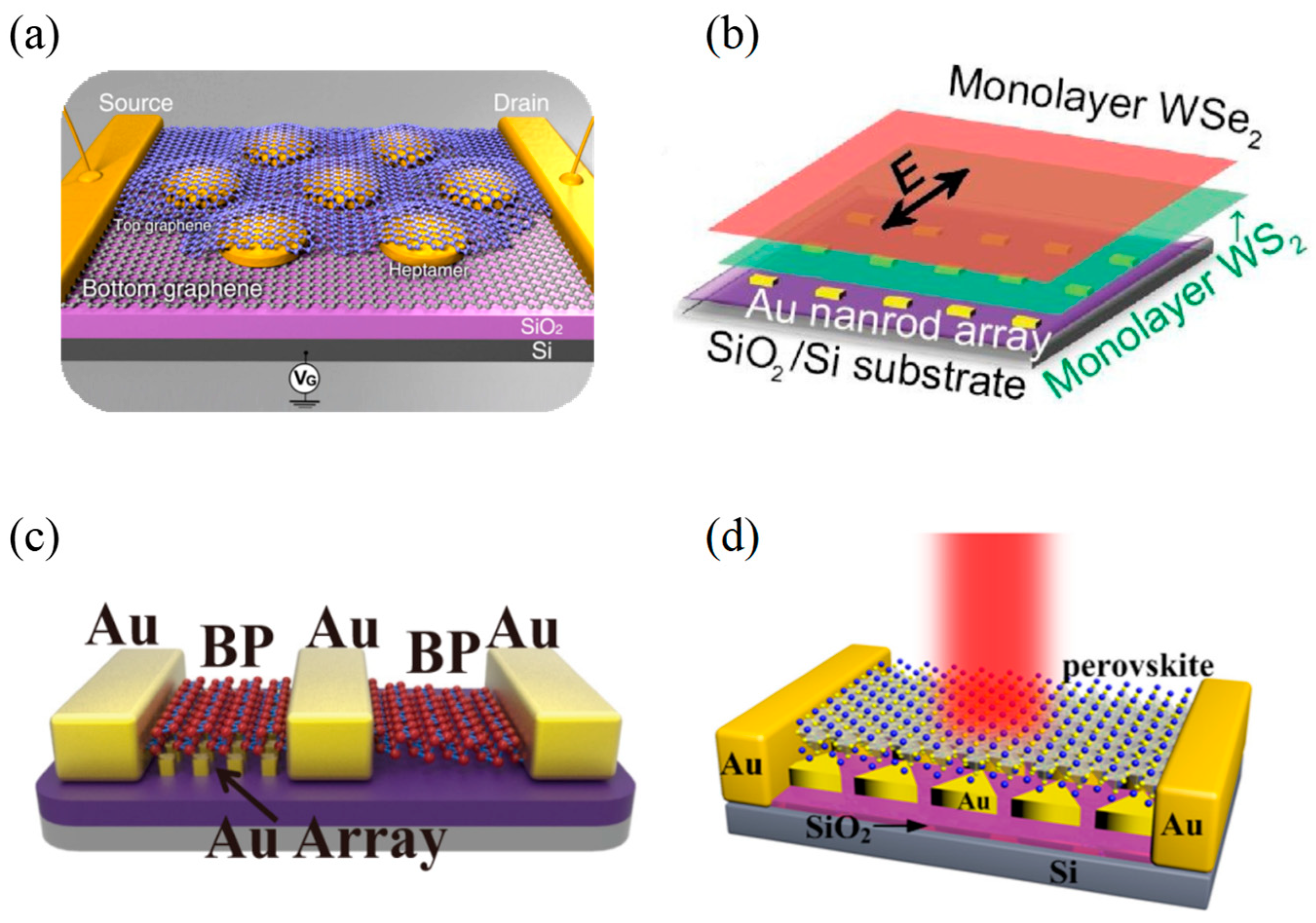
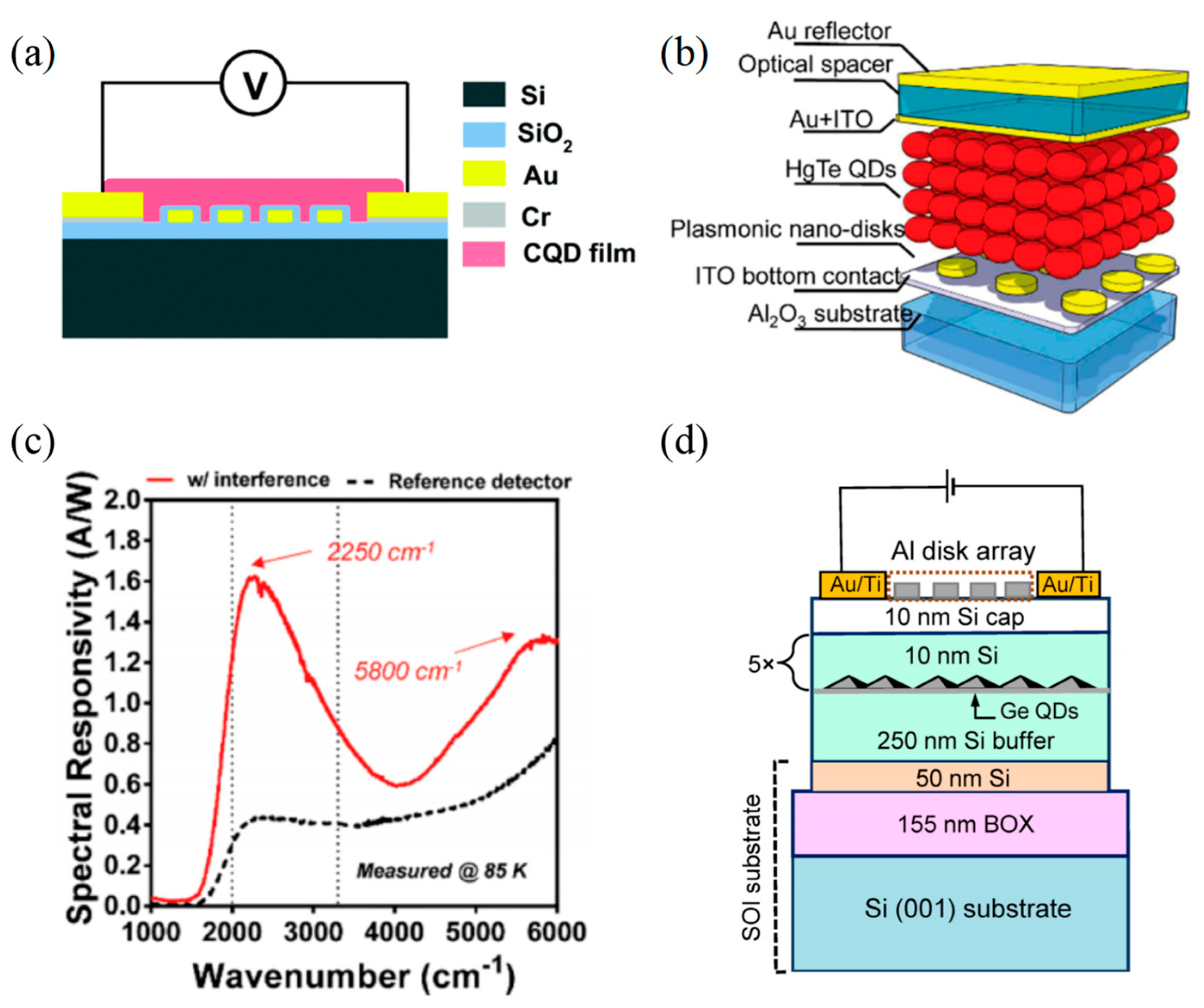
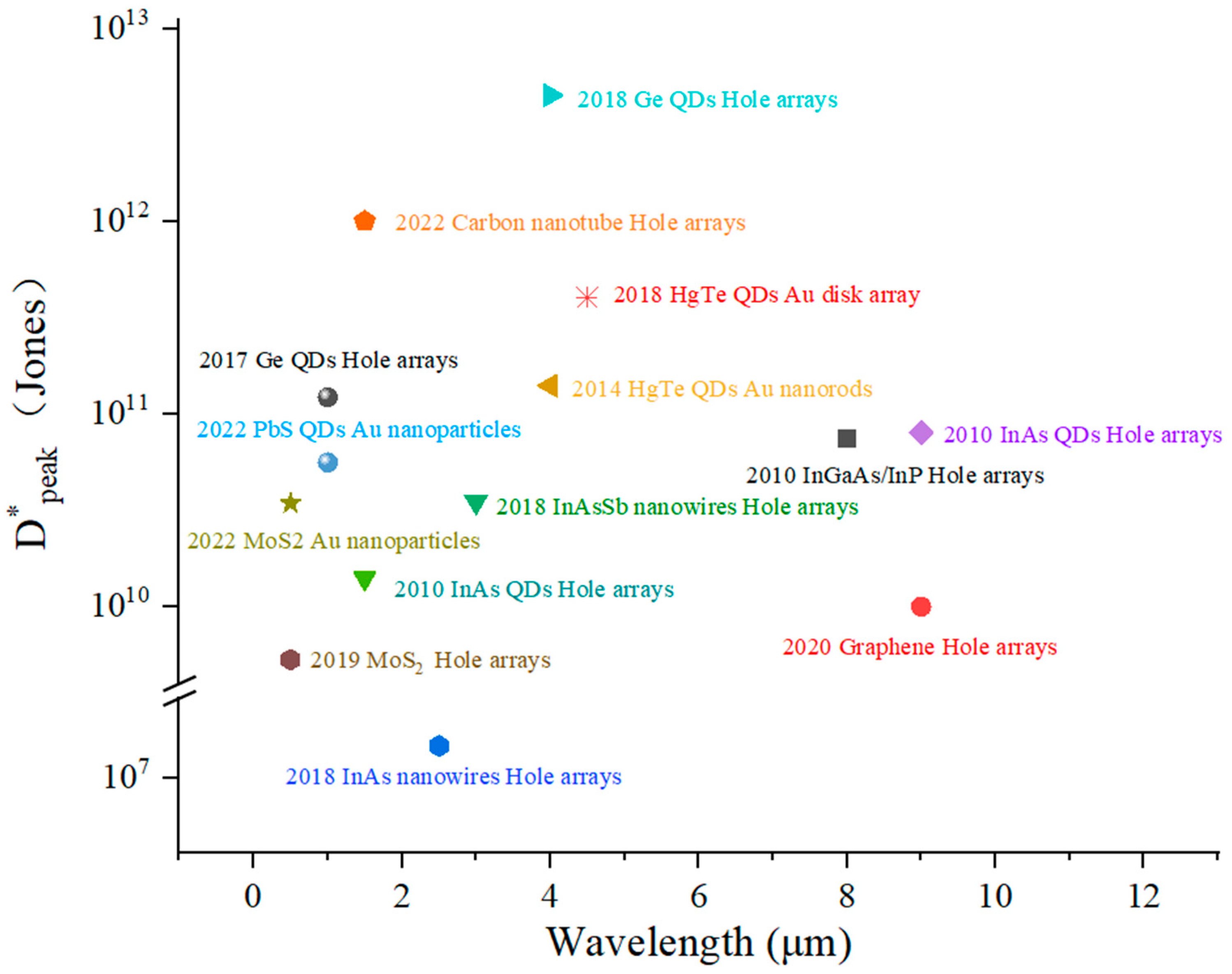
| Year | Plasma Structure | Nanomaterials Used | Spectral Range (μm) | Responsivity (A/W) | (Jones) | EQE/ IQE (%) | Ref. |
|---|---|---|---|---|---|---|---|
| 2010 | Hole arrays | InGaAs/InP | <8 | 7 | 7.4 × 1010 | - | [34] |
| 2020 | Hole arrays | graphene | <12 | - | ~1010 | - | [36] |
| 2011 | Hole arrays | InGaAs nanopillars | NIR | 0.28 | - | - | [37] |
| 2016 | Hole arrays | InAsSb nanowires | <3 | 0.194 | - | 29% | [38] |
| 2018 | Hole arrays | InAs nanowires | SWIR | ~1.5 × 10−3 | 2.5 × 107 | - | [39] |
| 2018 | Hole arrays | InAs(Sb) nanowires | SWIR-MWIR | 0.75 | 3.5 × 1010 | - | [40] |
| 2010 | Hole arrays | InAs QDs | <12 | 1.02 | 8 × 1010 | - | [44] |
| 2017 | Hole arrays | Ge QDs | <6 | 0.04 | 1.4 × 1011 | - | [47] |
| 2018 | Hole arrays | Ge QDs | <6 | 0.42 | 4.5 × 1012 | 2% | [48] |
| 2022 | Au grating | Black phosphorus | MWIR | 0.077 | - | 4% | [56] |
| 2021 | Au grating | Ge nanowire | NIR | 0.75 | - | - | [57] |
| 2020 | Circular grating | InP Nanowire | NIR | 0.96 | - | 163% | [60] |
| 2014 | Au nanoparticles | Graphene | NIR | 1.5 | 2.52 × 1014 | - | [63] |
| 2015 | Au nanoparticles | Graphene | 0.4–0.8 | 700 | 1013 | - | [65] |
| 2019 | Au nanospheres | WS2 | Visible-NIR | 1050 | - | - | [67] |
| 2019 | Au nanoparticles | MoS2 | 0.7–1.6 | 0.064 | - | - | [68] |
| 2019 | Au nanoparticles | MoS2 | - | 0.024 | 5.3 × 109 | - | [69] |
| 2022 | Au nanoparticles | MoS2 | - | 1757 | 3.44 × 1010 | 4106% | [73] |
| 2014 | Au nanoantennas | Si nanowire | NIR | 0.1 | - | - | [75] |
| 2022 | Au nanoparticles | Carbon nanotube | SWIR | 0.476 | 1 × 1012 | - | [76] |
| 2022 | Au nanoparticles | GaAs nanowire | NIR | 6.56 | 5.6 × 1010 | - | [77] |
| 2012 | Ag nanoparticles | PbS CQDs | NIR | ~300 | - | - | [78] |
| 2014 | Ag nanocrystals | PbS CQDs | NIR | 0.0038 | 7.1 × 1010 | ~11% | [79] |
| 2014 | Au nanorods | HgTe CQDs | NIR-MWIR | - | ~1.5 × 1010 | ~7% | [80] |
| 2019 | Au nanorods | PbS CQDs | NIR | 18.5 | 1.22 × 1011 | 2844% | [81] |
| 2020 | Au nanorods | PbS CQDs | NIR | 8.2 | 6.3 × 1010 | 1251% | [82] |
| 2012 | nanoantenna | Graphene | NIR | 0.013 | - | 22% | [83] |
| 2020 | Au triangle arrays | perovskite | Visible-NIR | 0.051 | - | 12.6% | [87] |
| 2016 | Au disk arrays | HgSe CQDs | MWIR | 0.1487 | - | - | [91] |
| 2018 | Au disk arrays | HgTe CQDs | MWIR | 1.62 | 4 × 1011 | 45% | [92] |
| 2020 | Al disk arrays | Ge/Si QDs | NIR | 0.05 | - | - | [93] |
Disclaimer/Publisher’s Note: The statements, opinions and data contained in all publications are solely those of the individual author(s) and contributor(s) and not of MDPI and/or the editor(s). MDPI and/or the editor(s) disclaim responsibility for any injury to people or property resulting from any ideas, methods, instructions or products referred to in the content. |
© 2023 by the authors. Licensee MDPI, Basel, Switzerland. This article is an open access article distributed under the terms and conditions of the Creative Commons Attribution (CC BY) license (https://creativecommons.org/licenses/by/4.0/).
Share and Cite
Yan, N.; Qiu, Y.; He, X.; Tang, X.; Hao, Q.; Chen, M. Plasmonic Enhanced Nanocrystal Infrared Photodetectors. Materials 2023, 16, 3216. https://doi.org/10.3390/ma16083216
Yan N, Qiu Y, He X, Tang X, Hao Q, Chen M. Plasmonic Enhanced Nanocrystal Infrared Photodetectors. Materials. 2023; 16(8):3216. https://doi.org/10.3390/ma16083216
Chicago/Turabian StyleYan, Naiquan, Yanyan Qiu, Xubing He, Xin Tang, Qun Hao, and Menglu Chen. 2023. "Plasmonic Enhanced Nanocrystal Infrared Photodetectors" Materials 16, no. 8: 3216. https://doi.org/10.3390/ma16083216
APA StyleYan, N., Qiu, Y., He, X., Tang, X., Hao, Q., & Chen, M. (2023). Plasmonic Enhanced Nanocrystal Infrared Photodetectors. Materials, 16(8), 3216. https://doi.org/10.3390/ma16083216









